Sony VAIO SE: An IPS Laptop for Under a Grand
by Jarred Walton on April 3, 2012 5:40 PM ESTSony VAIO SE Application Performance
Sony opted to ship us a higher spec variant of the VAIO SE, which of course helps out with their ranking in some of the benchmarks. Even so, the base model Core i5-2450M is hardly a slouch in performance. The i7-2640M we’re testing is clocked 12% higher and can Turbo Boost 13% higher, so unless you really need every bit of performance you can wring out of your CPU, we’d suggest sticking with the i5-2450M. A far better use of $210 (the cost to upgrade to the i7-2640M) would be to switch to an SSD, as that will add far more than 12% better performance to many mundane tasks, and SSDs aren’t prone to fragmentation and the horrible sluggishness that plagues PCs after a year or so of heavy use.
As usual, we’ve got several laptops with SSDs in the charts below, and those will rise to the top in tests like PCMark. Other tests will focus more on pure CPU or GPU performance. If you’re wondering how the base model VAIO SE might perform, look at the VAIO SB results—the HD 6470M and i5-2410M are close enough to what you’ll get from the SE that it should help set your expectations. We also have a couple higher-end laptops/notebooks in the charts, but the main reason we’re including the HP EliteBook 8760w is for the LCD comparison later on in the review.
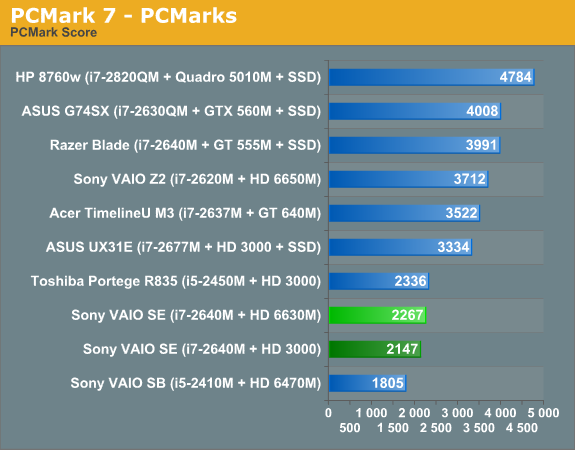


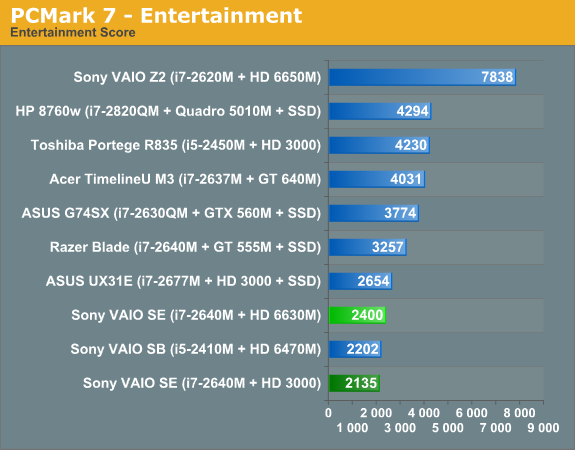

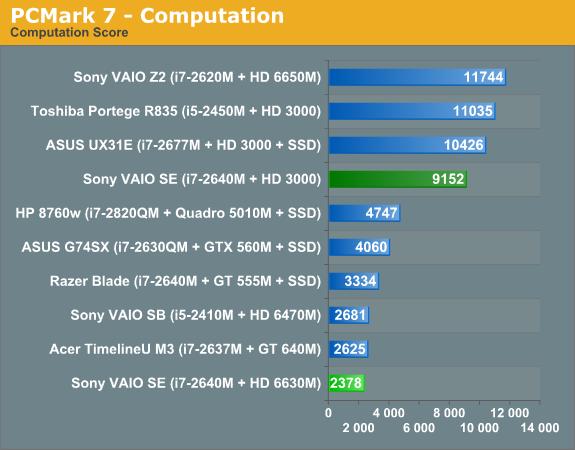
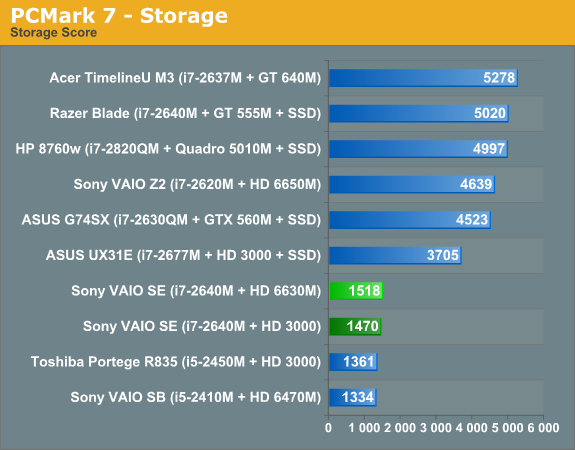
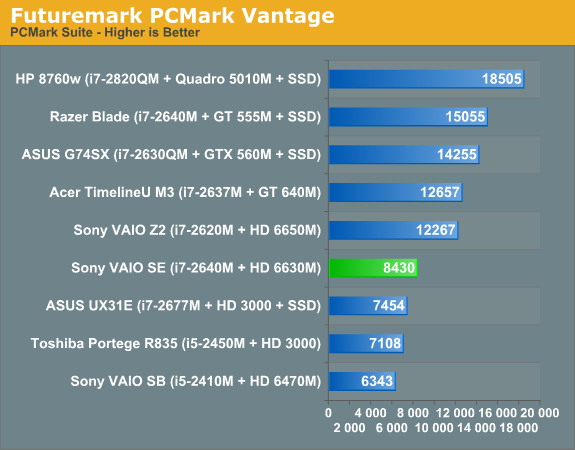
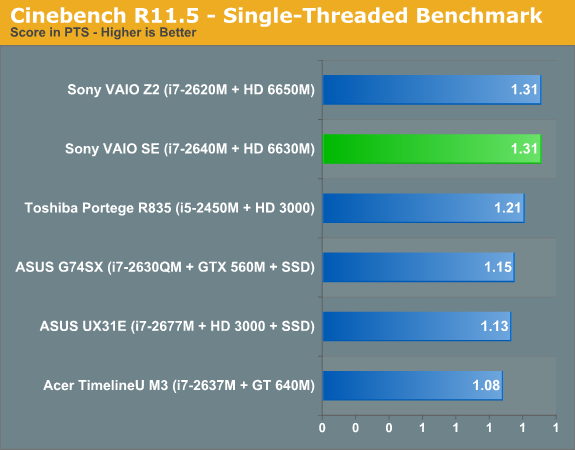
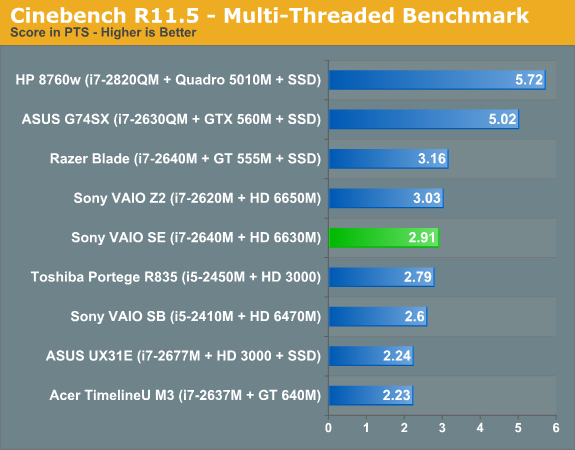
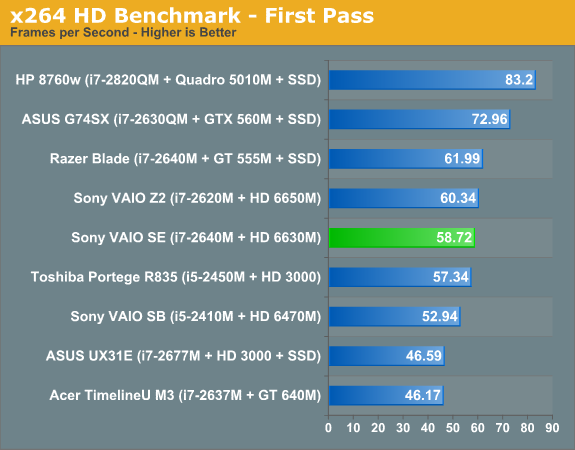

There’s not a whole lot to say about the performance. The VAIO SE falls right about where you’d expect given the configuration we’re testing. It’s interesting to point out that the Razer Blade uses the same CPU as the SE, with a GPU that’s certainly faster and a chassis that provides a bit more cooling potential. Optimus also allows you to dynamically switch between the IGP and dGPU, and we’ve used the dGPU results for PCMark 7 so certain tasks that can use Quick Sync (e.g. Computation and Creativity) take a hit. PCMark 7 and Vantage benefit quite a bit from the presence of an SSD; the closest the VAIO SE gets to the Razer Blade is the IGP Computation score, where the Blade still leads by 31%. Some of that most likely comes from drivers as well, but we can’t say for certain how much is drivers, how much is cooling, and how much is the SSD.
Something else to pay attention to in the CPU-centric benchmarks is how the various dual-core i7 laptops stack up. The VAIO SE and Razer Blade both use the newer i7-2640M while the VAIO Z2 we tested has an i7-2620M; that should result in the SE coming in ahead of the Z2, but Cinebench and x264 encoding both have the Z2 and Blade leading the SE by a small margin. This is likely a result of CPU thermals preventing the SE from hitting maximum Turbo Boost frequencies as often, which is quite surprising considering the Z2 is a 13.1” chassis while the SE is a 15.5” design.
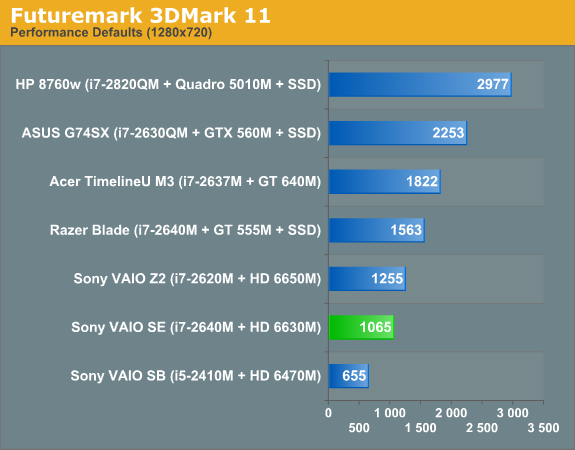

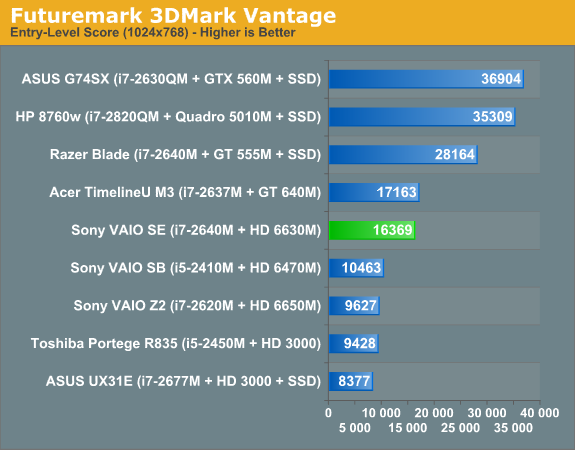
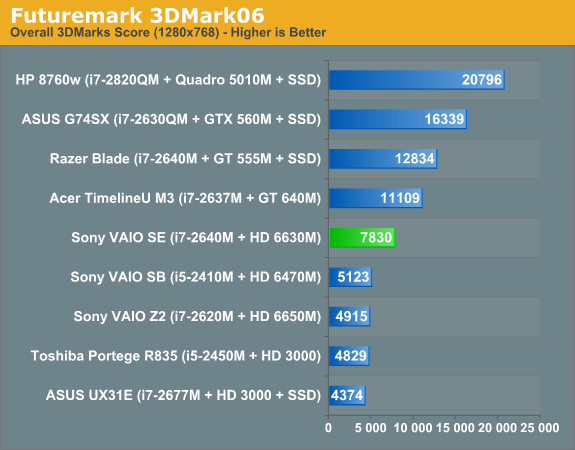
As for 3DMarks, again performance is about what you can expect from the HD 6630M. The VAIO SE clearly isn’t intended as a gaming laptop—particularly if you opt for the base model with HD 6470M graphics—but it can still handle most games at lower resolutions and medium detail. There are also a couple odd results where the 6630M in the SE comes out significantly ahead of the 6650M in the Z2. That could be partly a case of different drivers, but more likely is that the external GPU can’t reach maximum performance while piping content back to the integrated 1080p displays. As for what this means for playing games, let’s get to the actual gaming benchmarks and see what happens.










59 Comments
View All Comments
goobah - Wednesday, April 4, 2012 - link
Thank you for the reply Jarred :)Much appriciated but I ment the castle name itself not the picture. That hilly out cropping on the sea is just so weird wanted to try google earthing it and look around:)
jmunjr - Wednesday, April 4, 2012 - link
The se13fx/b is the original version of the SE series that is basically identical aside from some minor CPU/GPU upgrades on the new Se2. Mine has the i5-2430M, 4GB RAM, 6470M and same display... So yeah you can get this laptop for well under $1000 from a very reputable vendor.Oh and btw the Lenovo X220 with an IPS has sold for ~$750 on many occasions...
jabber - Wednesday, April 4, 2012 - link
...seemed to give middling performance.Still seems to be a toss up between a really good TN panel or a below average IPS as the best options.
Not a good position really.
Snotling - Wednesday, April 4, 2012 - link
My only beef with sony is the lack of availability of keyboards other than english on many of their models. Why the hell did they send a 5400rpm drive equipped unit for review is a mystery to me. Maybe they just can't avoid being stupid.effingee - Wednesday, April 4, 2012 - link
"NVIDIA’s Optimus Technology switches on-the-fly between IGP and discrete graphics as needed, you can still get driver updates from NVIDIA and Intel without worrying about compatibility issues"Will those driver updates have to come through Sony? If so, it could take a while and they might only release a couple of them.
JarredWalton - Wednesday, April 4, 2012 - link
No, that's the beauty of Optimus: all the major OEMs participate in NVIDIA's Verde driver program, so basically every laptop with NVIDIA graphics (Optimus or discrete only) can use NVIDIA's reference drivers. The only laptops that aren't part of the Verde program (AFAIK) are laptops with manually switchable graphics--like the old ASUS UL80VT (I think that's the correct model) or the early Sony VAIO Z with GT 330M.Zoomer - Saturday, April 14, 2012 - link
Manually switchable graphics does have an edge in compatibility. No software support is needed; but a reboot might be needed to switch graphics around.Christopher29 - Wednesday, April 4, 2012 - link
That was really kind review for this laptop - I mean THIS quality (or lack of it), faulty cooling design, flexible screen and overal issues that this hardware has ... it is Amazing that it got Editors Choice.Well ... I highly recommend less "influenced" (biased?) reviews on notebookcheck.com. They do some serious tests and if something lacks quality, stablility (Anand do You really think that this laptop will not throttle down with this temps?) then it is always pointed clearly in bold, not "mildly mentioned".
I've also experienced many issues with those laptops, warranty policy is ridiculous, and there are (were) cases in court in my country regarding refuse to service laptops. Sony states that after selling laptops there is no their responsibility but only company that service for them is responsible and also decide whether free repair is granted or not. Also they will not exchange LCD if there are badpixels , less than three as I remember in "central part of screen". Servicing company for SONY is sued because they refuse to repair broken lcd (vaio hinge desing and lack of sturdines brought cracking tension to screens) here is link: http://www.twojeartykuly.info/rozne/laptop-sony-va... (Or english via GTranslate: http://translate.google.pl/translate?sl=pl&tl=...
JarredWalton - Wednesday, April 4, 2012 - link
First off, while this is AnandTech, Anand doesn't review all the hardware. I wrote the review, and I clearly spelled out the potential concerns. The hardware did not throttle for most use cases. If you want to run Furmark or do heavy 3D rendering or video encoding, then I'd stick with other options -- Dell's XPS 15 comes to mind as a competitive solution that can handle a quad-core CPU.Claiming bias just because someone likes a laptop that you haven't even used or probably seen is... well, biased. As for Notebookcheck, all they have is links to external reviews of the same laptop, most of which give the SE an 80%+ rating. That's a pretty good score in my book.
Sounds like you just have an ax to grind with Sony, with your complaints about customer service, dead pixels, etc. If you buy a laptop in the US and you don't like it, you can pretty much always return it for a refund -- worst case you pay a 15% restocking fee. For Poland (I assume that's where you're from), maybe they're not as willing to take back hardware. But once again, you're biasing your review off of your own location.
VAIO SE summary:
Good IPS display, a display that's better than any TN laptop IMO, reasonable cost, good performance
Not perfect colors, questionable exhaust location, loose hinge
The editor's choice is almost purely for the virtue of including an IPS display for a laptop that costs less than $1000. There are many users who want exactly that. "OMG bias -- you like good displays!" Yup. Sorry.
Zoomer - Saturday, April 14, 2012 - link
The temps are likely a design decision, not random. The fan probably is running at the minimum speed while keeping temps below some threshold. Sony's engineers probably decided that 90-ish degrees is acceptable.Screen wise, some idiot manager/marketer probably forced that through to shave an extra 0.5 mm off the thickness.